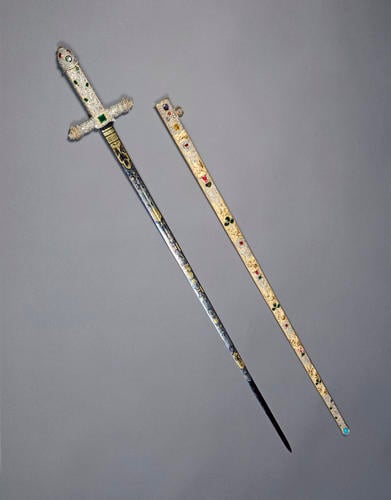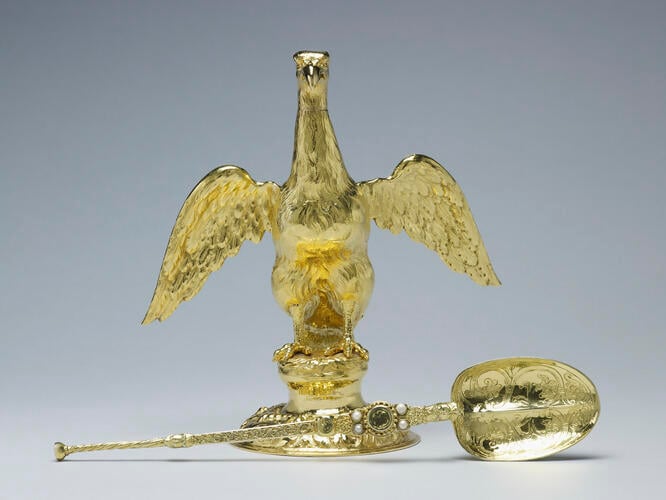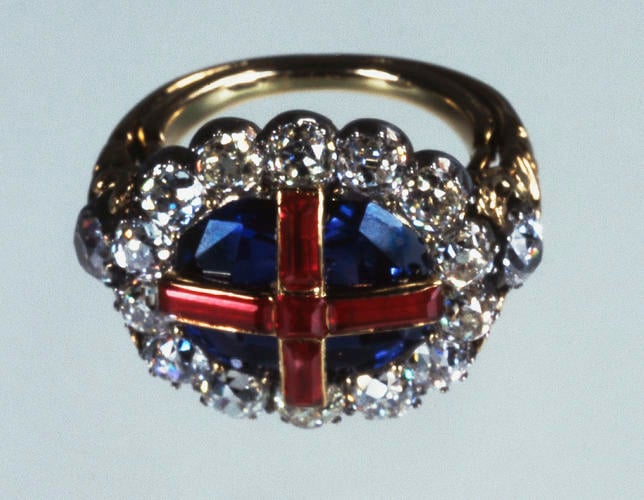In the Jewel House at the Tower of London, armed guards keep watchful eyes over regalia made of the most precious metals fitted with the most beautiful gemstones. Therein lie the Crown Jewels—ever-enduring symbols of a long line of monarchs that have ruled over Britain and the United Kingdom for many centuries.
The Crown Jewels are made up of 140 royal ceremonial objects with 23,578 gemstones. This article will cover the major items in the regalia and the history of the collection.
St. Edward’s Crown

Named after Saint King Edward the Confessor, the St. Edward Crown is the single most important piece of the Crown Jewels. This solid Gold crown is only used when crowning a new monarch. The original is believed to date back to the 11th century, with this version having been first made in 1661 for Charles II’s coronation.
The gems on the crown were previously just hired for the coronation and returned afterwards. It was only during George V’s crowning in 1911 that St. Edward’s Crown was permanently set with Rubies, tourmalines, topazes, zircons, aquamarines, amethysts, Sapphires, garnet, peridot, and spinel.
The Sovereign’s Sceptres


At the end of the investiture during the coronation, the monarch is handed the Sovereign’s Sceptre with Cross and the Sovereign’s Sceptre with Dove, also known as the Rod of Equity and Mercy.
The Sovereign’s Sceptre with Cross symbolises the monarch’s temporal power, while the Rod of Equity and Mercy represents the monarch’s spiritual role with guidance from the Holy Ghost depicted as the dove.
Both are made of Gold and studded with Diamonds, Emeralds, Rubies, Sapphires, and spinels. The Star of Africa, the world’s biggest top-quality cut white Diamond, is set in the heart-shaped frame of the Sovereign’s Sceptre with Cross.
Imperial State Crown
The Imperial State Crown was made in 1937 and is what the monarch wears during formal occasions. It has 2,868 Diamonds, 269 pearls, 17 Sapphires, 11 Emeralds, and 4 Rubies.
The most famous of these gemstones is the “Black Prince’s Ruby”, set right on the front of the crown. It is actually a spinel and not a Ruby. However, its significance cannot be understated, as it is the stone given to Edward, the Black Prince of Wales, in 1367 by King Pedro the Cruel of Castile, after Edward helped beat Pedro’s rival in battle.
The Swords of State

During the procession of the coronation, the monarch is presented with five ceremonial swords that symbolise their authority as Commander-in-Chief of the British Armed Forces and Defender of the Faith.
The Sword of Mercy, the Sword of Spiritual Justice, and the Sword of Temporal Justice are brought as the monarch enters Westminster Abbey. The Sword of State is exchanged for the Sword of Offering.
The Sword of Offering is then used to gird and bless the monarch. Pictured above, the Sword of Offering has a gilded leather sheath with 1,251 Diamonds, 16 Rubies, 2 Sapphires, and 2 Turquoises. It also has a Damascus steel blade with 2,141 Diamonds, 12 Emeralds, and 4 Rubies.
The Ampulla and Anointing Spoon

The coronation includes the anointing of the monarch with holy oil by the Dean of Westminster. Containing this oil is the hollow Gold vessel Ampulla, made in the shape of an eagle, with its beak as the spout from where the oil comes out of. The oil is poured onto the Silver-gilt Coronation Spoon, which is then used to pour oil onto the monarch.
The Coronation Spoon is the only remaining piece from the original set of Crown Jewels that was destroyed at the end of the English Civil War in 1649.
The Sovereign’s Orb

The Sovereign’s Orb is a small, hollow Gold sphere with a band of precious stones on its equator, another band of precious stones at the upper half, and a gemstone-encrusted cross at the top that symbolises the Christian world. It is given to the monarch during the investiture rites of the coronation and then placed on the altar. It features Diamonds, Rubies, Sapphires, Emeralds, Pearls, and Amethysts.
The Sovereign’s Ring

Symbolising “kingly dignity” and the wearer’s marriage to the nation, the Sovereign’s Ring is placed on the monarch’s fourth finger by the archbishop during the coronation.
The Rubies cut to form a cross over an octagonal Sapphire represent the red cross of St. George on the blue background of St. Andrew’s Cross. Sixteen Diamonds are also set on the Gold ring.
A Brief History of the Crown Jewels
The origins of the Crown Jewels go all the way back to 1161, when Edward the Confessor was granted sainthood and his regalia elevated to the status of holy relics. The monks of Westminster Abbey held these items and proclaimed that they were to be maintained and used when crowning a new monarch.
As Westminster Abbey was owned by the English monarchy, Edward’s regalia was treated as royal property. The establishment of this tradition marked Europe’s first known set of hereditary coronation regalia.
The tradition of passing down St. Edward’s Crown was first recorded during Henry III’s coronation in 1220. By taking on these royal vestments, authority was symbolically transferred from the previous sovereign to the next. This was practised even with England’s conquest of Wales in 1282 and Scotland in 1296, as these nations’ crowns were surrendered in the process.
It was during the Tudors’ reign that three swords and an orb were introduced to the regalia. The English Reformation in the 16th century lessened the role of St. Edward’s regalia during coronation, as they were deemed medieval relics that should not be so venerated.
The regalia were officially declared the “Jewels of the Crown” by Parliament in 1642 to prevent Charles I from exporting these items for money.
The conflict between Parliament and the monarchy escalated into the English Civil War, which resulted in Charles I’s execution in 1649 and the creation of the English Republic. The Crown Jewels were destroyed to fund the Republic, with the precious stones removed, the metals melted, and the Gold minted as coins.
Oliver Cromwell’s death in 1658 led to the monarchy’s restoration under the rule of Charles II. The Crown Jewels were recreated to be identical to the originals for Charles II’s 1661 coronation.
Since then, the collection has grown to 140 ceremonial objects that are still in use today, attracting millions of tourists to the Tower of London every year.








